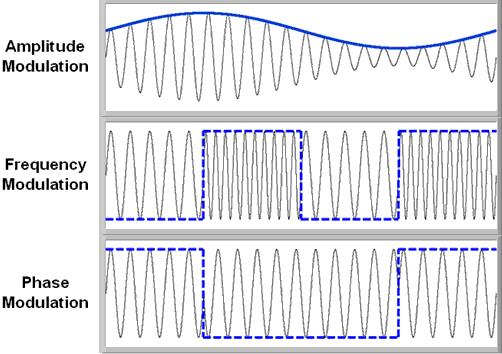Modulation

Modulation is the addition of information (or the signal) to an electronic or optical signal carrier. Modulation can be applied to direct current (mainly by turning it on and off), to alternating current, and to optical signals. One can think of blanket waving as a form of modulation used in smoke signal transmission (the carrier being a steady stream of smoke).Morse code, invented for telegraphy and still used in amateur radio, uses a binary (two-state) digital code similar to the code used by modern computers. For most of radio and telecommunication today, the carrier is alternating current (AC) in a given range of frequencies. Common modulation methods include:
- Amplitude modulation (AM), in which the voltage applied to the carrier is varied over time
- Frequency modulation (FM), in which the frequency of the carrier waveform is varied in small but meaningful amounts
- Phase modulation (PM), in which the natural flow of the alternating current waveform is delayed temporarily
These are sometimes known as continuous wave modulation methods to distinguish them from pulse code modulation (PCM), which is used to encode both digital and analog information in a binary way. Radio and television broadcast stations typically use AM or FM. Most two-way radios use FM, although some employ a mode known as single sideband (SSB).
More complex forms of modulation are Phase Shift Keying (PSK) and Quadrature Amplitude Modulation (QAM). Optical signals are modulated by applying an electromagnetic current to vary the intensity of a laser beam.
Modem Modulation and Demodulation
A computer with an online or Internet connection that connects over a regular analog phone line includes a modem. This term is derived by combining beginning letters from the words modulator and demodulator. In a modem, the modulation process involves the conversion of the digital computer signals (high and low, or logic 1 and 0 states) to analog audio-frequency (AF)tones. Digital highs are converted to a tone having a certain constant pitch; digital lows are converted to a tone having a different constant pitch. These states alternate so rapidly that,if you listen to the output of a computer modem, it sounds like a hiss or roar. The demodulation process converts the audio tones back into digital signals that a computer can understand. directly.
Multiplexing
More information can be conveyed in a given amount of time by dividing the bandwidth of a signal carrier so that more than one modulated signal is sent on the same carrier. Known as multiplexing, the carrier is sometimes referred to as a channel and each separate signal carried on it is called a subchannel. (In some usages, each subchannel is known as a channel.) The device that puts the separate signals on the carrier and takes them off of received transmissions is a multiplexer. Common types of multiplexing include frequency-division multiplexing (FDM) and time-division multiplexing (TDM). FDM is usually used for analog communication and divides the main frequency of the carrier into separate subchannels, each with its own frequency band within the overall bandwidth. TDM is used for digital communication and divides the main signal into time-slots, with each time-slot carrying a separate signal.




